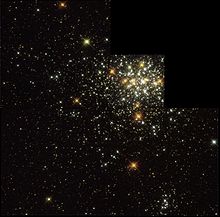astro.wikisort.org - Galaxy
NGC 1818 is a young globular cluster in the north-west part of the Large Magellanic Cloud, about 3.2 kpc from the center.[7] It was discovered by Scottish astronomer James Dunlop in 1826,[8] and has since been well studied.[4]
| NGC 1818 | |
|---|---|
 A Hubble Space Telescope (HST) image of NGC 1818 | |
| Observation data (J2000 epoch) | |
| Constellation | Dorado |
| Right ascension | 05h 04m 13.300s[1] |
| Declination | −66° 26′ 05.47″[1] |
| Distance | ~164 kly (50 kpc)[2] |
| Apparent magnitude (V) | 9.7 (B band)[3] |
| Physical characteristics | |
| Absolute magnitude | −8.8[4] |
| Mass | 13,500+5,600 −3,700 M☉ |
| Estimated age | 30[5] or 40 Myr[6] |
| Notable features | Rare young globular |
The cluster has an estimated core radius of 2.67 pc and a 90% light radius of 13.83 pc,[1] with a combined mass of around 13,500 times the mass of the Sun.[5] Age estimates for the cluster range from 25[7] to 40[6] million years. Given this, most stars with a mass equal to the Sun or less are still on the pre-main-sequence. The average stellar metallicity – what astronomers term the abundance of elements with higher atomic number than helium – is −0.4, or about 10−0.4 ≈ 40% of the abundance in the Sun.[4]
There appear to be two distinct stellar populations in the cluster with the more blue (hotter) stars showing slower rotation rates than the redder (cooler) stars.[6] The frequency of binary star systems in the cluster increases with distance from the core, which is the opposite of the normal trend for globular clusters. This may be explained by interactions with other stars in the denser core disrupting binary systems, before mass segregation of the cluster has begun to take effect.[5] The cluster contains few if any blue stragglers, which are the result of stellar mergers.[7]
References
- Werchan, Felicia; Zaritsky, Dennis (August 2011). "The Star Clusters of the Large Magellanic Cloud: Structural Parameters". The Astronomical Journal. 142 (2): 10. arXiv:1105.1769. Bibcode:2011AJ....142...48W. doi:10.1088/0004-6256/142/2/48. 48.
- Elson, Rebecca; Sword, Richard; NASA. "Hot white dwarf shines in young star cluster NGC 1818". Hubblesite. Retrieved 2020-08-26.
- SIMBAD (January 8, 2007), Results for NGC 1818, SIMBAD, Centre de Données Astronomiques de Strasbourg
- Liu, Q.; de Grijs, R.; Deng, L. C.; Hu, Y.; Baraffe, I.; Beaulieu, S. F. (July 2009). "The initial mass function of the rich young cluster NGC 1818 in the Large Magellanic Cloud". Monthly Notices of the Royal Astronomical Society. 396 (3): 1665–1674. arXiv:0903.4787. Bibcode:2009MNRAS.396.1665L. doi:10.1111/j.1365-2966.2009.14838.x.
- Geller, Aaron M.; et al. (May 2015). "Different Dynamical Ages for the Two Young and Coeval LMC Star Clusters, NGC 1805 and NGC 1818, Imprinted on Their Binary Populations". The Astrophysical Journal. 805 (1): 11. arXiv:1503.05198. Bibcode:2015ApJ...805...11G. doi:10.1088/0004-637X/805/1/11. 11.
- Marino, A. F.; et al. (September 2018). "Different Stellar Rotations in the Two Main Sequences of the Young Globular Cluster NGC 1818: The First Direct Spectroscopic Evidence". The Astronomical Journal. 156 (3): 10. arXiv:1807.04493. Bibcode:2018AJ....156..116M. doi:10.3847/1538-3881/aad3cd. 116.
- Johnson, R. A.; et al. (2001). "Young star clusters in the Large Magellanic Cloud: NGC 1805 and 1818". Monthly Notices of the Royal Astronomical Society. 324 (2): 367. arXiv:astro-ph/0012389. Bibcode:2001MNRAS.324..367J. doi:10.1046/j.1365-8711.2001.04291.x.
- Seligman, Courtney. "NGC 1818". Celestial Atlas. Retrieved 7 December 2018.
External links
 Media related to NGC 1818 at Wikimedia Commons
Media related to NGC 1818 at Wikimedia Commons- NASA Astronomy Picture of the Day: NGC 1818: A Young Globular Cluster (7 March 1998)
- NASA Astronomy Picture of the Day: NGC 1818: Pick a Star (15 April 1998)
- NASA Astronomy Picture of the Day: NGC 1818: A Young Globular Cluster (11 March 2001)
На других языках
[de] NGC 1818
NGC 1818 ist die Bezeichnung für einen Kugelsternhaufen, der mit der Großen Magellanschen Wolke im Sternbild Schwertfisch assoziiert ist. NGC 1818 hat einen Durchmesser von 3,4' und eine scheinbare Helligkeit von 9,7 mag. Dieser Kugelsternhaufen ist wahrscheinlich erst 40 Millionen Jahre alt, ganz im Gegensatz zu den meisten Kugelsternhaufen der Milchstraße, die oft über 10 Milliarden Jahre alt sind. Er zählt daher zu den blauen Kugelsternhaufen. NGC 1818 wurde am 3. August 1826 vom schottischen Astronomen James Dunlop entdeckt.[4]- [en] NGC 1818
[es] NGC 1818
NGC 1818 es un cúmulo globular en la constelación de Dorado situado en la Gran Nube de Magallanes. A 164 000 años luz de distancia de la Tierra, es uno de los cúmulos más jóvenes que existen, con una edad de solo 40 millones de años. Es un cúmulo diez veces mayor que los que existen en nuestra vecindad en la Vía Láctea y contiene estrellas muy masivas.[ru] NGC 1818
NGC 1818 (другое обозначение — ESO 85-SC40) — рассеянное скопление, которое находится в Большом Магеллановом Облаке (БМО), соседней карликовой галактике. Расстояние до него составляет около 163 тысяч световых лет. Этот объект входит в число перечисленных в оригинальной редакции «Нового общего каталога».Другой контент может иметь иную лицензию. Перед использованием материалов сайта WikiSort.org внимательно изучите правила лицензирования конкретных элементов наполнения сайта.
WikiSort.org - проект по пересортировке и дополнению контента Википедии